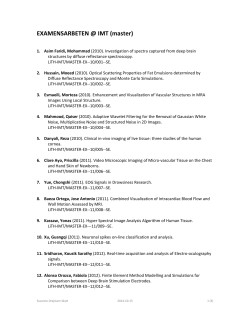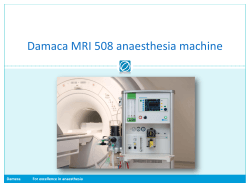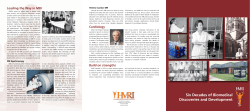
BIOE 220/RAD 220 REVIEW SESSION January 23, 2011
BIOE 220/RAD 220 REVIEW SESSION January 23, 2011 Your TAs • Physics TA: Michael Marx, mikemarx@stanford.edu • Anatomy TA: Shubhra Jain, jainshubhr@gmail.com • We will have weekly review sessions, Mondays at 5:30 in the Lucas Learning Center. We will review the material from the previous lectures and then have time for questions and homework help. • Please feel free to email us with any questions. We will reply within 24 hours to email, and can make time for additional meetings outside of the review sessions if there’s demand. • If you would like us to cover something specific at the weekly review session, please email us both by Sunday night. Today’s Schedule 1. Course Overview – Setting expectations 2. Basics of MRI, MRI Review 3. Imaging Conventions 4. Neuro-Anatomy Review 5. Time For Questions Course Overview - Outline • • • • • • • • • • • • • • • • • • • Jan 9 – Introduction, MR Signal, CNS Overview Jan 11 – MR Relaxation, Brain Anatomy 1(Lobes, Gyri, Sulci) Jan 18 – Radiography, DSA, CT Jan 23 – Contrast Agents, MR Gradients, DWI, 1D Localization, Brain Anatomy 2 (Deeper Structures, Cerebellum, Pituitary) Jan 25 – MRA, Orbits, Brain Coverings, Neurovascular Anatomy Jan 30 – MR Slice Selection, Sampling, SNR Feb 1 – Ultrasound Feb 6 – Brain Development Feb 8 – MR Image Formation Feb 13 – Rendering Lab Feb 15 – Midterm Feb 22 – US Doppler, Carotid Anatomy, US Lab Feb 27 – Spine and Spinal Cord Feb 29 – MR Pulse Sequences, Angiography, Quantitative Flow Applications Mar 5 – Perfusion Imaging, Cranial Nerves Mar 7 – fMRI, Oxygenation, Brain Autoregulation in Health and Disease Mar 12 – MR Lab Mar 14 – DTI, Functional Neuroanatomy & Review Mar 23 – Friday – 8:30 Final Exam Course Overview - Expectations • The course is split about 50/50 between physics and anatomy when it comes to class time, homework problems, and exam questions • Engineering students are often stronger with the physics and weaker with anatomy • Science or medical students are often the reverse • Differences in student backgrounds should mostly balance out, so don’t worry too much about it • The first physics lectures (MRI intro) are about as difficult as they get this quarter, so don’t extrapolate difficulty and get worried • Movies on the web site should help with MRI intuition • For anatomy, repetition is key to memorization. Make sure to review the slides, videos, and other resources • You will be given a list of terms that you’re responsible for on an exam, so you don’t need to memorize spelling Basics of MRI – B0 • MRI measures oscillating magnetic fields created by spinning water protons • A large magnetic field B0 is applied in the ẑ direction • This magnetic field is always on, created by a superconducting electromagnet (cooled by liquid helium) • The ẑ direction points through the magnet, which will generally be P/I direction • Left at rest, net magnetization M0 will align in the ẑ direction • We can’t measure magnetization in the same direction as B0, so it’s necessary to rotate the magnetization into the transverse (xy) plane to measure it Basics of MRI – Precession Frequency • Protons rotate at a frequency determined by the gyromagnetic ratio • 𝑓0 ≣ Larmor frequency = γB0 • γ = 42.58 MHz/T for water hydrogen • Typical clinical scanners will be 1.5T or 3.0T • In “lab frame,” our coordinate system is stationary, so the spins rotate at the Larmor frequency • In “rotating frame,” the coordinate system rotates about ẑ at the Larmor frequency, so spins (magnetization) appear stationary Basics of MRI – RF Pulses • To measure M0, it must be tipped into xy plane • In rotating frame, we can apply a magnetic field B1 to apply a torque to M • Rotation due to B1 can be calculated using Larmor frequency • τ = M x B, so you can figure out direction of rotation using right hand rule (point fingers towards M, curl them towards B, your thumb points in the direction of the torque) Basics of MRI – Relaxation • Protons that aren’t perfectly on-resonance (rotating at expected Larmor frequency) will rotate in rotating frame • Magnetization in the transverse plane decays quickly due to dephasing • Fast dephasing is T2’ decay, which contributes to T2* • This is imaged with GRE – Gradient Recalled Echoes • Transverse magnetization can be refocused with a 180 degree pulse, which refocuses some of the off resonance • Refocused intensity decays with T2 • This is imaged with SE – Spin Echoes • As long as the spins are in the presence of B0, T1 recovery will be occurring • Magnetization in the ẑ direction will be recovering towards M0 Basics of MRI – Relaxation Coefficients • Different tissues in the body will have different T1 and T2 coefficients • These differences are what provide contrast in MRI images • Images can be given different weighting (contribution from T1, T2, and M0) based on the pulse sequence timings • Materials with a longer T2 tend to have longer T1 • Stationary fluid has very long recover times, so it will appear very bright in T2 weighting and dark in T1 weighting… easiest way to figure out weighting • You should memorize this equation, and understand it well enough to re-derive it: • Contrast Summary MRI Basics – Contrast Summary Echo Time (TE) Repetition Time (TR) short short T1-weighted PD-weighted long No contrast T2-weighted long 31 Imaging Conventions Axial Plane ( CT, MR) CT v/s MRI • If cortical bone is bright, it’s CT. • If cortical bone is dark, it’s MRI. • If fat is bright, it’s MRI. • Fat can be dark or bright on MRI. • Hints: MRI is really good for looking at the musculature. Abdominal imagers really like CT. CT Knee Cortical bone is bright Fat is dark Proton Density-Weighted MRI Knee Fat is bright. Cortical bone is dark, fluid is bright X-ray CT, US, PET, or MRI?? X-ray CT, US, PET, or MRI?? X-RAY, CT, US, PET, OR MRI?? X-ray CT, US, PET, or MRI?? X-ray CT, US, PET, or MRI?? Overview of the nervous system • Central nervous System • Brain • Spinal Cord • Cranial Nerves • Peripheral Nervous System • Peripheral Nerves Lobes Ipsilateral vs contralateral frontal parietal occipital temporal Limbic Lobe Ventricles Lateral Third Fourth Neuro Anat - Practice 1, Sylvian fissure. 2, Globe. 3, Superior temporal gyrus. 4, Middle temporal gyrus. 5, Inferior temporal gyrus. LF, Frontal Lobe. LP, Parietal Lobe. Neuro Anat - Practice 1, Amygdale. 2, Optic nerve. 3, Globe. 4, Inferior rectus muscle. 5, Right maxillary sinus. 6, Hippocampus. 7, Cerebellar hemisphere. 8, Transverse sinus. 9, Occipito-temporal gyri. 10, Lateral ventricle. Neuro Anat - Practice 1, Sphenoid sinus. 2, Genu of corpus callosum. 3, Lateral ventricle. 4, Superior sagittal sinus. 5, Straight sinus. 6, IVth ventricle. 7, Cerebellomedullary cistern (cisterna magna). Neuro Anat - Practice 1, Superior frontal gyrus. 2, Middle frontal gyrus. 3, Inferior frontal gyrus. 4, Medial orbital gyrus. 5, Turbinate. 6, Gyrus rectus. Neuro Anat - Practice 1, Hippocampus. 2, Inferior frontal gyrus. 3, Middle frontal gyrus. 4, Superior frontal gyrus. 5, Cingulate gyrus. 6, Lateral ventricle. 7, Third ventricle. 8, Middle cerebellar peduncle. 9, Medulla. Neuro Anat - Practice 1, Superior sagittal sinus. 2, Calcarine fissure. 3, Cerebellar hemisphere. 4, Transverse sinus . 5, Straight sinus. 6, Interhemispheric fissure. Neuro Anat - Practice 1, Optic nerve. 2, Medial rectus muscle. 3, Globe. 4, Lateral rectus muscle. 5, Right temporal lobe. 6, Pons. 7, Right occipital lobe. 8, Left occipital lobe. Neuro Anat - Practice 1, Frontal sinus. 2, Sylvian fissure. 3, Insula. 4, 3rd ventricle. 5, Lateral ventricle. LF, Frontal Gyri. LT, Temporal gyri. LO, Occipital Gyri. Neuro Anat - Practice 1, Genu corps callosum. 2, Superior frontal gyrus. 3, Lateral ventricle. 4, Central sulcus.
© Copyright 2025
















